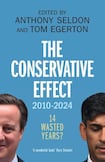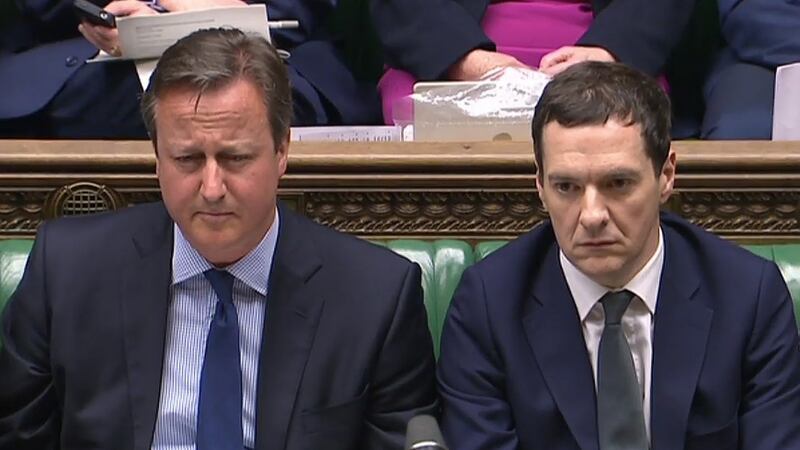
The publicity bumf surrounding The Conservative Effect, 2010-2024: 14 Wasted Years? rather appropriately includes a report card that will be well understood by the products of English public schools, many of whom served over those years.
The final report card of “Whitehall College” – including the emblem “Pauci Enim Non Multi” – “For the Few, Not the Many” – reviews its head boys and girls since 2010: David Cameron, Theresa May, Boris Johnson, Elizabeth Truss and Rishi Sunak.
Under “Verdict”, it declares: “Multo plures sunt qui vincere sciunt quam qui recte uti victoria”, or “There are many more who know how to win than who properly use victory”. For an inscription on a political tomb, the motto has considerable merits.
Fifteen writers, including leading British historian Anthony Seldon and Prof Brendan O’Leary, investigate the performance of the administrations that have been in command, if that word can be used, of 10 Downing Street since 2010. The judgments are nearly always brutal, with a few exceptions.
READ MORE
Erratic changes in policies, often completely contradictory, and a procession of politicians occupying, then moving on or being fired from ministerial office, have long since destroyed hope of stability in the corridors of British power.
This is the seventh project led by Seldon, dating from Margaret Thatcher, probing the difference that governments make, shorn of the distortion of party politics and the ephemera of day-to-day public debate.
Setting the landscape, leading pollster and journalist Peter Kellner ponders whether successes or failures can be fairly judged by looking at the Conservatives’ 14 years in power from 1951 to 1964 through a longer lens of history. Is the party to be praised, for example, for then refusing changes on abortion and homosexuality because its views reflected the majority views of the public, or condemned because those views have not stood the test of time?
[ What’s eating Britain? A look at the issues gripping its soulOpens in new window ]
Notwithstanding such qualifications, the report card on the Conservatives’ performance since 2010 is deeply negative, even if the early-years difficulties were brought on by a global financial crisis it did not create, but nor did it herald.
David Cameron won in 2010 because he convinced voters in England that he could be trusted with the National Health Service – “the closest thing the English have to a national religion”, in the words of Nigel Lawson.
Back then it was in a good place: 2½ million people were waiting for treatment in England, but the number waiting for more than three months had fallen from 700,000 to just 7,000. Virtually nobody waited more than six months.
The NHS was so central to the UK’s psyche that film director Danny Boyle put it at the heart of his 2012 London Olympics display, “with children jumping on hospital beds surrounded by dancing nurses”, writes Rachel Sylvester.
By 2023 the NHS had broken all the wrong records. Elective surgery waiting lists had tripled, reaching 7.8 million and set for more than eight million by the end of this year, regardless of who wins the election on July 4th. England’s social care crisis is so bad that a 10th of all hospital beds are filled by people who cannot be discharged.
Every health service has struggled in the past decade. Ageing alone across the western world guarantees that. There are now 11 million people in England and Wales over 65, including half a million over 90.
Nearly 1.6 million older people, according to Age UK, do not get essential daily supports; 2.6 million over-50s have some unmet care need; and there were 165,000 staff vacancies in social care in England last year, up 52 per cent increase on the year before.
[ The Irish Times view on the 75th anniversary of the NHS: a system under strainOpens in new window ]
However, much of the UK’s crisis is politically home-grown – policy driven by ideology, not pragmatism, especially endless reforms that were frequently abandoned, or that failed to deliver on promises, along with spending curbs.
Sometimes actions work. In 2018 the soft drinks industry faced a significant levy on sugar – one that cut the amount of sugar used from 135,500 tonnes to 87,600 tonnes in just four years. More could have been done.
The political culture of the time – one that endlessly moaned about “the nanny state” – curbed a lot of the actions that could have improved the health of a population that too often eats badly and takes too little exercise.
Subsequent actions failed in the face of ideology. Boris Johnson, so lamentable in so many ways, wanted to ban TV junk food advertising before 9pm and end “buy one, get one free” promotions on unhealthy products, but failed to get it past his own people.
The financial crash prepared the way for Cameron by destroying Labour’s reputation for economic dependability, even if the Labour prime minister, Gordon Brown, can legitimately claim to have saved the global financial system by his actions then.
Unemployment peaked at 2.7 million in 2011, while household wealth across the UK fell by nearly £1 trillion between 2008 and 2009, shortly before the Conservatives ousted Labour, though the damage lingered for years.
However, argues Tom Egerton, David Cameron and George Osborne took the wrong course by imposing austerity after 2010. Despite the Conservatives’ weaponisation of Labour’s Liam Byrne’s “there’s no money left” jest to his successor, the Liberal Democrats’ David Laws, the reality was nowhere as bad.
Debt stood at 65 per cent of GDP and the deficit peaked at 10 per cent, but the situation was eased substantially by historically low interest rates.

Cameron and Osborne captured the “narrative of fear”, blaming the financial crisis on state overspending and the euro-zone crisis rather than placing the blame where it lay: with an overleveraged financial system.
The wrong choices made then, Egerton argues, set the scene for everything else that followed: “rising inequality, a weakened pound, reduced trust in elites, sluggish growth and stagnating wages”.
The scale of the cuts between 2010 and the Covid crisis in 2020 highlighted by Paul Johnson, Carl Emmerson and Nick Redpath are staggering – “the biggest and most sustained cuts” since at least 1945. Although the deficit fell by 2018 – before the Covid-19 pandemic upturned every plan – the actions taken were more painful and protracted than originally planned.
However, the UK’s record on growth since 2010 – which has frequently been a problem since the second World War – has been even worse. Productivity and national income per head have been virtually stagnant, with serious implications for wages and living standards – outcomes that do much to explain the mood across the UK today.
Wages have not risen in real terms since 2010, rising in nominal terms from £450 per week to £650 per week. “There has been no longer period without growth in real wages since the Napoleonic Wars,” they write.
Productivity per hour is 13 per cent lower than Germany’s and 8 per cent lower than France’s, while median household income – the midway point between the richest and poorest homes – is 22 per cent below Germany.
The UK’s decades-long “chronic underinvestment” in public and private capital spending has long since come to roost, explaining many of the problems now afflicting British society. That is accepted by many senior figures, such as former permanent secretary to the treasury Nick MacPherson, who says the UK should have borrowed more when interest rates were historically low.
Britain is not a good place to be poor. That has become even more true over the last 14 years
— Authors Michael Marmot and Clare Bambra
Cameron’s defining, self-inflicted injury, Brexit, overhangs everything, politically, economically and socially – a result that has brought considerable harm and no tangible benefit.
Capital spending fell off a cliff after the Brexit referendum and had only just recovered to 2016 levels by 2023 – an outcome found nowhere else among big economies.
Frequent shifts during the Brexit negotiations, from the question of whether or not to stay in the single market “to frequent high-profile threats of a ‘No Deal’ Brexit with tariffs on trade” damaged investment, the authors argue. And it has failed miserably to deal with the one issue that perhaps most led to Brexit’s victory: immigration. Numbers from the European Union have fallen, yes, but the numbers from elsewhere have rocketed.
On inequality, the judgment of authors Michael Marmot and Clare Bambra is damning: “Britain is not a good place to be poor. That has become even more true over the last 14 years.”
Median household income in the UK in 2022 before taxes and benefits was £35,000, increasing to £38,100 after taxes and benefits. But the richest fifth had a mean income of £117,500 – 14 times larger than the poorest fifth, who struggled by with £8,200.
Despite all the talk of “levelling up” and the Conservatives’ seizure of traditionally Labour-held “Red Wall” seats in 2019 on the back of Boris Johnson’s popularity, the reality is that inequalities have worsened significantly.
“Let the implications sink in: the health of the poorest people and places got worse; life expectancy went down; living with illness went up; and thousands of families lost loved ones before their time. It is an unprecedented calamity,” they write.
The Conservative Effect should be read by all political geeks but, most of all, if he can find the time, by the man who will next occupy No 10, Labour’s Keir Starmer. It offers a withering obituary on a political chapter that has done much harm and little good.
Further reading
How They Broke Britain, by James O’Brien (2023), is the left-wing broadcaster’s ruthless, angry denunciation of the cloaked elites who have so dominated British politics and persuaded so many, so often to vote against their own best interests.
How Westminster Works ... and Why It Doesn’t, by Ian Dunt (2023), is a deep dive into the reaches of British politics. Why do its institutions work or fail to work in the way that they do, and why is the British public so unable to understand who controls the levers of power, and why?
And for something with a longer reach: Inside Story: Politics, Intrigue and Treachery from Thatcher to Brexit, by Philip Webster (2016). The author is a renowned journalist, who had a ringside seat on history from his perch in the House of Commons press gallery – a story told with skill, depth and kindness.














